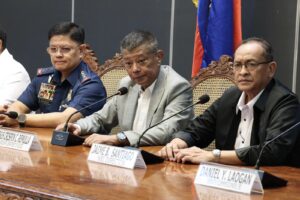Consider yourself lucky if you have regular business or leisure activities in any of the 27 prominent sites around the Clark Freeport Zone (CFZ) in Pampanga included in the 27 stops of the Clark Loop, a public transport system with the CFS that resumed operations in September.
Congratulations, Clark commuters! You now have a convenient transportation option, which is one of the commitments of President Ferdinand R. Marcos Jr. to the Filipino people as part of his Philippine Development Plan (PDP) 2023-2028.
In his previous official engagements, President Marcos has consistently advocated for an improved transportation system, highlighting its multiplier effect on many industries.
“We will continue to invest and improve on our transportation systems as well as to pursue more projects in the years to come, so that Filipinos can gain greater access to places of work, commerce, recreation, and other vital areas,” he said
President Marcos also went on to assure the public that the government is “working hard to improve the country’s transportation systems, operations, and management for the benefit of present and future generations.”
A testament to the steady improvement of the transport system is the Clark Loop using a fully cashless payment system via beep cards, Clark Loop is aimed at giving commuters, visitors, and workers in CFZ a convenient transportation option. The base fare is P15 for the first five kilometers, plus an additional P2.50 per kilometer.
The maximum fare from the SM terminal to Clark International Airport is P49.50. By adopting beep card or beep QR tickets as exclusive modes of payment, the Clark Loop has eliminated cash handling, making it more hygienic for commuters.
Initially, the roll-out of the Clark Loop was under the Bases Conversion Development Authority (BCDA) but the operations had since been assumed by the Clark Development Corporation (CDC), with the project’s official launch on September 17.
The Loop will initially have two routes: a northbound route from SM City Clark to Clark International Airport, and a southbound route that will run in the opposite direction. The first trip from SM City Clark Gate 1 leaves at 6am on weekdays and 7am on weekends.

The first bus at the south-bound route leaves from Mabalacat Gate at 5:20am with a 30-minutes interval during peak hours and every 60 minutes during off peak hours or during weekends.
Clark Loop buses operate daily, departing from the terminal every 15 minutes during peak hours and every 30 minutes or 60 minutes during off-peak hours.
CDC initially rolled out an initial fleet of 10 Clark Loop buses, each with a minimum seating capacity of 42. All are fully air-conditioned for a comfortable ride.
Upgrading the transport system in the country has always been part of the thrusts of the government under the leadership of President Ferdinand Marcos: He has said, “We will continue to invest and improve our transportation system as well as pursue more projects in the years to come so that Filipinos can gain greater access to places of work, commerce, recreation, and other vital areas.”
“Having an effective and efficient transportation system will have multiplier effects on employment, the economy, and our society. It will also bring comfort, convenience, and an easier life for all,” President Marcos added.
Many areas across the country are already heeding the president’s call for a better mass transport system. And the Clark Loop is one notable example.
Since its launch, the Clark Loop has made commuting faster, more convenient, and digital-ready within the CFZ. Clark Loop also offers alternative transportation for other commuters, like students of the University of the Philippines Diliman Extension Program in Pampanga.

There are 10 units of buses, with eight plying on a regular basis while the two buses are designated as “back-up” in the event of technical problems so as not to disrupt the scheduled departure and arrival of buses from the stations.
CDC President and CEO Agnes Devanadera said additional two more buses to the initial fleet is already in the process.
This is the first transport system in Central Luzon that accepts cashless payment in partnership with Beep card operator AF Payments Inc. (AFPI), allowing commuters to hop on, tap their beep cards upon entering, then tap out upon alighting the bus.
Commuters can also purchase Beep QR tickets in advance exclusively through the Beep app, downloadable in the App Store or Google Play. The QR ticket must be used within 24 hours from the time of purchase. To use it, simply scan the QR ticket upon riding the bus.
Devanadera said: “Ito ay mga buses na aircon, may wifi… Sa ngayon ay sampu pa lang pero meron kaming idadagdag na dalawa. Ito ang magdadala ng mga tao papuntang loob ng Clark. At very reasonable ang price, 15 pesos from other points. Ito rin ang magdadala ng tao papunta sa airport. So from SM Papuntang airport, ito na ang sasakyan nila. Sa halagang kinse pesos sy napaka reasonable nito. Pero ang pinaka mahalaga dito ay ang ating mga workers, ang ating mga nagtatrabaho ay hindi na. magbabayad ng mahal.”
Clark Loop is touted by AFPI as a clear example of how cities can leverage digital payment systems to improve public services. AFPI said this serves as a model for other cities and municipalities to emulate as they aim to modernize their own public transport systems, provide better services to local commuters, reduce congestion, and shorten travel times.
Devanadera said, “We want to showcase a disciplined transport system in Clark, and this government-led pilot will help us refine the service before allowing private sector involvement. We are starting with 10 buses on the Clark Loop. It’s cashless, with Wi-Fi and GPS, and it runs on time. Our aim is to influence passenger behavior, emphasizing discipline and punctuality.”
Chris, a Clark Loop passenger studying at UP Clark, said the Clark Loop is a useful alternative when he gets left behind by the jeepney he usually rides.
“Yung loob OK sya… (May) maayos din na upuan and marami yung capacity nya. Komportable,” Chris said.
He added that “Mas less yung anxiety na… na wala kang masakyan, kasi pag grab or taxi syempre mahal, di namin afford. Pero Clark Loop, though mas higher sya sa Jeep, ayun nga mas good alternative sya. Tapos may security na makakaiuwi ka or makakalabas ka talaga ng Clark kasi may dagdag na transportation.”
Levi Ann Ramirez, another Clark Loop passenger, described the Clark Loop as “convenient.” She added, “Komportable po kami kasi may aircon, at saka easy po syang gamitin.”
As to waiting time, Levi Ann said, “OK naman po… kasi paglabas po namin, naghihintay lang po kami ng mga minutes tapos nandyan na po si Loop.”
Did she find the cashless payment easy to manage?
Levi Ann said, “Yes, mas madali po kasi madali naman pong i-load yung Loop. Through Gcash po, tapos meron na rin po sa SM pag magpapa-load po kayo.
When asked how the Clark Loop compares to the other transport options in Clark, Levi Ann said, “Yun po kasing sa jeep minsan po syempre siksikan… Compared po sa Loop… tapos mas convenient nga po dahil may aircon, at saka mas malinis po syempre… Mare-recommend po. Aprub na aprub po yan.”
Devanadera said the volume of Clark Loop passengers proves that there is demand for a more modernized transport system within the CFZ.
She said, “September 17, 2024 lang ito naumpisahan. As of November 30, 2024, nakapag serbisyo na tayo sa 56,000 passengers. Malayo pa tayo sa target, pero nakikita natin na talagang may demand, may pangangailangan. So ito na ang tugon ng Clark Development Corporation para sa yung tinatawag nating seamless transportation, so maeengayo ang mga tao na pumunta rin dito.”
According to Devanadera, while the CDC is taking steps to support modernization in the transport sector, no jeepney drivers plying the streets of Clark will be left behind or will lose their jobs because of Clark Loop.
“Ang nais din naming iparating sa mga kasama nating jeepney operators, walang mawawalan ng trabaho,” she said.
“Tuluy-tuloy pa rin ang mga jeep dahil yung Clark Loop ay nasa main streets. Ang lahat ng side streets ay kasama na rito ang ating mga jeepney operators,” she added.
Devanadera also thanked the locators who initially provided shuttle buses for their employees but may now find there is no more need for such an added company expense. She said, “Nais ko rin naman pasalamatan ang ating mga locators dahil meron silang mga shuttle buses. Itong shuttle buses na mini-maintain ng mga locators ay nakakataas din ng cost ng kanilang pagnenegosyo dito sa Clark. Ngayon kung ating matutulungan katulad ng ginawa natin sa Clark Loop ay maeenganyo ang mamumuhunan na pumunta rito sa Clark dahil bumaba ang cost of doing business.”
The 27 Loop stops are: SM City Clark Gate 1, SM City Clark Flagpole, Mercedes-Benz Clark, Aderans/Laus Group (Laus Auto Services), Friendship Gate, Philexcel Gate, Clark Center, Bertaphil I, Clark Electric, Sapang Bato/7-Eleven, Amertron, CDC BOSS (Building 2126), CDC Corporate Office, CDC Parade Grounds/Children’s Playground, Barn Houses/Quest Hotel, Clark Museum Royce Hotel & Casino, Filinvest, Mimosa Plus, Widus Hotel/Hann Casino Resort, St. Joseph the Worker Chapel 2, Puregold Clark/UP Clark, Centennial Road, Texas Instruments/El Kabayo Clark, Clark Picnic Grounds/Dinosaur Island, Clark International Airport, Mabalacat Gate and the Clak One-Stop Government Center.



